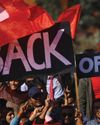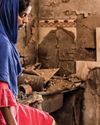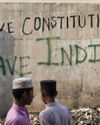
Teresita Boljoran, now a widowed mother in her early fifties, has been cleaning houses since 2010 to support her family of six. In 2013, the super typhoon Haiyan-locally known as Yolanda-destroyed her house on the island of Malapascua, in Cebu province in the Philippines. Yolanda was one of the most powerful typhoons ever recorded in the country, affecting more than 14 million people and claiming over six thousand lives. "For a year, we lived in makeshift tents on the beach until we were able to rebuild the house thanks to several [government] aids," Boljoran told me, in May 2022. Many such typhoons on Malapascua have forced her to rebuild her life from scratch. "Although I always live with the uncertainty of what might happen," she said, "I don't intend to leave here."
Each year, about twenty severe cyclones, which cause torrential rains and heavy floods, hit the archipelagic state comprising thousands of islands. The worst affected are the poorest, who live in fragile structures on the coastland and are exposed to extreme weather conditions. In 2022, five tropical cyclones made landfall in the Philippines, triggering floods and landslides. Like most years, they resulted in deaths, property destruction, damage to agriculture and infrastructure, as well as displacement of thousands of people and disruption in their livelihoods.
This story is from the April 2023 edition of The Caravan.
Start your 7-day Magzter GOLD free trial to access thousands of curated premium stories, and 8,500+ magazines and newspapers.
Already a subscriber ? Sign In
This story is from the April 2023 edition of The Caravan.
Start your 7-day Magzter GOLD free trial to access thousands of curated premium stories, and 8,500+ magazines and newspapers.
Already a subscriber? Sign In

Mob Mentality
How the Modi government fuels a dangerous vigilantism

RIP TIDES
Shahidul Alam’s exploration of Bangladeshi photography and activism

Trickle-down Effect
Nepal–India tensions have advanced from the diplomatic level to the public sphere

Editor's Pick
ON 23 SEPTEMBER 1950, the diplomat Ralph Bunche, seen here addressing the 1965 Selma to Montgomery March, was awarded the Nobel Peace Prize. The first black Nobel laureate, Bunche was awarded the prize for his efforts in ending the 1948 Arab–Israeli War.

Shades of The Grey
A Pune bakery rejects the rigid binaries of everyday life / Gender

Scorched Hearths
A photographer-nurse recalls the Delhi violence

Licence to Kill
A photojournalist’s account of documenting the Delhi violence

CRIME AND PREJUDICE
The BJP and Delhi Police’s hand in the Delhi violence

Bled Dry
How India exploits health workers

Status Update
India’s telling silence on the Hagia Sophia controversy